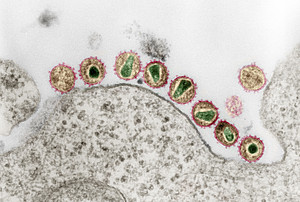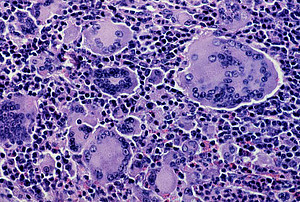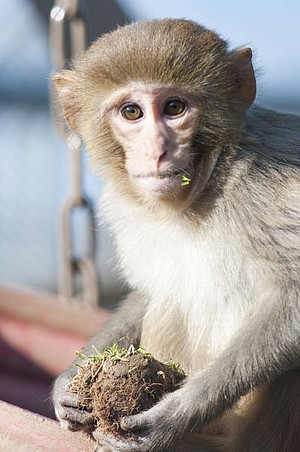At the German Primate Center the researchers of the Infection Biology Unit and Unit of Infection Models investigate HIV and SIV.
The Human Immunodeficiency Virus (HIV) causes the immunodeficiency disease AIDS (Acquired Immunodeficiency Syndrome). HIV is spreading continuously since the 1980s and is a worldwide epidemic (pandemia). The number of newly infected people and AIDS outbreaks is stagnating in central Europe due to prevention and progress in medication-based treatment, but at the same time it is increasing in eastern Europe. A HIV-Infection is not curable, yet. AIDS is one of the ten most frequent causes of death worldwide.
According to estimations of the World Health Organization (WHO) there are recently about 34 million people worldwide infected with the HI-virus (WHO AIDS report 2012). Only about half of the HIV carriers have access to so called antiretroviral therapies, which delay the outbreak of AIDS and reduce the risk of infecting other people, like e.g. the dissemination of the virus from a mother to her unborn child. The main distribution area of AIDS today is the sub-Saharan-region in Africa where 69 percent of all infected persons worldwide live.

HIV is transmitted via body fluids such as blood, sperm, vaginal secretion, breast milk or liquor, but not through tears, saliva or sweat. By the current state of knowledge, these body fluids do not contain enough viruses for a transfer.
The disease AIDS is the result of an HI-infection. Its spread within the body destroys the immune system and causes a number of symptoms like tumors or lymph node swellings and infections with numerous pathogens, which would be successfully attacked by the immune system in a healthy person.
A method for fighting an HI-infection is the combined Antiretroviral Therapy (cART). The cART was introduced in 1996 and has reduced the mortality rate in persons who have received the therapy during the first five years by 94%. cART is a therapy, which combines several drugs to suppress the reproduction of HI-viruses in the body to a level at which AIDS does not outbreak.

HIV belongs to the group of complex retroviruses. An envelope and a single strain RNA-genome containing its genetic information characterize retroviruses. Retroviruses have to transfer the information on their RNA-strain into a DNA molecule and integrate this into the genome of the host cell to infect it. There are two types of HIV. The HIV-1 type is worldwide spread and the reason for the HIV/AIDS pandemia, while infections with HIV-2 are mainly recognized in West Africa and are characterized by a less aggressive course of disease.
The HI-virus was discovered in 1983 by three researchers of the Institut Pasteur in Paris. Analyses on the origin of the virus have pointed towards related viruses in African apes, the simian immunodeficiency viruses (SIV). It is assumed that SIV from chimpanzees (SIVcpz) was transmitted to humans repeatedly and that the today worldwide spread HIV-1 viruses of the group M have developed out of one of those viruses. The transmission probably occurred during the 1930s in Cameroon and could be linked to the hunt and consumption of apes that were infected with SIV. HIV-2, on the other hand, derived out of the SIV (SIVsm) from Sooty mangabeys (cercocebus atys), which was repeatedly transmitted to humans as well. An infection with SIVsm in Asian macaques causes an AIDS-like disease and viruses, that are isolated from these animals, are called SIV from macaques (SIVmac). The experimental infection of macaques with SIVmac is one of the model systems for the HIV infection in humans.

The researchers of the Unit of Infection Models investigate under the direction of Dr. Christiane Stahl-Hennig inter alia potential vaccines against the Human Immunodeficiency Virus. The unit investigates the synthesis and development of the disease AIDS and the effects of preventive medicamentation on the outbreak of the disease with the help of a rhesus macaque (Macaca mulatta) animal model. The DPZ scientists also work on determining the influence of genetic factors of patients on the progress of an infection.
The Infection Biology Unit with its head Stefan Pöhlmann investigates how the virus enters its host cell. The viral surface protein Env (envelope protein) plays a central role in the host cell entry process. Env recognizes proteins on the surface of host cells and mediates the fusion of HI-virus envelope with the membrane of the cell that is to be infected. The team of the Infection Biology Unit also investigates new inhibitors, which could hinder the cell entry and might be developed as new therapies in the future. Furthermore, the team is interested in the question of how the composition of the glycan envelope of the Env-protein influences the mucous transmission of HIV.
To answer these questions, the infection biologists at the DPZ work for example with the macaque/SIV model, which has been developed in cooperation with the units of Infection Models and Pathology.
Additional Links on HIV research

The KompNet HIV/AIDS is one of currently 21 medical competence networks of the German Federal Ministry of Education and Research (BMBF).

The main objective of HIVERA is the establishment of European-wide joint funding programmes on AIDS/HIV research.

Informationen on HIV research of the German Centre for Infection Research (DZIF e.V.).




